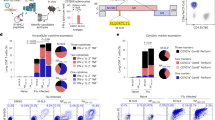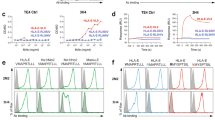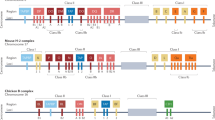Abstract
It is generally accepted that T lymphocytes recognize antigens in the context of molecules encoded by genes in the major histocompatibility complex (MHC). MHC class Il-restricted T cells usually recognize degraded or denatured rather than native forms of antigen on the surface of class II-bearing antigen presenting cells (reviewed in refs l, 2). It has recently been shown3 that short synthetic peptides corresponding to mapped antigenic sites of the influenza nucleoprotein (NP) can render uninfected target cells susceptible to lysis by NP-specific class I-restricted cytolytic T cells (CTL). These and earlier experiments4 that showed specific recognition of NP deletion mutant transfectants suggest that class I-restricted recognition might also involve processed antigenic fragments. One important issue arising from these studies is whether the model applies not only to viral proteins that are expressed internally (such as NP) but also to antigens normally expressed as integral membrane proteins at the cell surface. We have recently isolated class I-restricted mouse CTL clones that recognize class I gene products of the human MHC (HLA) as antigens in mouse cell HLA-transfectants5. Here we show that these anti-HLA CTL can lyse HLA-negative syngeneic mouse cells in the presence of a synthetic HLA peptide. These results suggest that the model applies generally.
This is a preview of subscription content, access via your institution
Access options
Subscribe to this journal
Receive 51 print issues and online access
$199.00 per year
only $3.90 per issue
Buy this article
- Purchase on Springer Link
- Instant access to full article PDF
Prices may be subject to local taxes which are calculated during checkout
Similar content being viewed by others
References
Unanue, E. R. A. Rev. Immun. 2, 395–428 (1984).
Grey, H. M. & Chestnut, R. Immun. Today 6, 101–106 (1985).
Townsend, A. R. M. et al. Cell 44, 959–968 (1986).
Townsend, A. R. M., Gotch, F. M. & Davey, J. Cell 42, 457–467 (1985).
Maryanski, J. L., Accolla, R. S. & Jordan, B. J Immun. 136, 4340–4347 (1986).
Van Pel, A., De Plaen, E. & Boon, T. Somatic Cell molec. Genet. 11, 467–475 (1985).
Pala, P. et al. in preparation.
Maryanski, J. L. et al. Eur. J. Immun. 15, 1111–1117 (1985).
Gomard, E. et al. Nature 319, 153–154 (1986).
Sodoyer, R. et al. EMBO J. 3, 879–885 (1984).
Strachan, T., Sodoyer, R., Damotte, M. & Jordan, B. R. EMBO J. 3, 885–894 (1984).
N'Guyen, C., Sodoyer, R., Trucy, J., Strachan, T. & Jordan, B. R. Immunogenetics 21, 479–489 (1985).
Orr, H. T. Lopez de Castro, J. A., Parham, P., Ploegh, H. L. & Strominger, J. L. Proc. natn. Acad. Sci. U.S.A. 76, 4395–4399 (1979).
Kvist, S., Roberts, L. & Dobberstein, B. EMBO J. 2, 245–254 (1983).
Sher, B. T., Nairn, R., Coligan, J. E. & Hood, L. E. Proc. natn. Acad. Sci. U.S.A. 82, 1175–1179 (1985).
Evans, G. A., Margulies, D. H., Camerini-Otero, R. D., Ozato, K. & Seidman, J. F. Proc. natn. Acad. Sci. U.S.A. 79, 1994–1998 (1982).
Jordan, B. R., Lemmonier, F. A., Caillol, D. H. & Trucy, J. Immunogenetics 18, 165–171 (1983).
Moore, K. W., Sher, B. T., Sun, Y. H., Eakle, K. A. & Hood, L. Science 215, 679–682 (1982).
Marglin, A. & Merrifield, R. B. A. Rev. Biochem. 39, 841–866 (1970).
Atherton, E., Logan, C. J. & Sheppard, R. C. J chem. Soc. Perkin I, 538–546 (1981).
Author information
Authors and Affiliations
Rights and permissions
About this article
Cite this article
Maryanski, J., Pala, P., Corradin, G. et al. H—2-restricted cytolytic T cells specific for HLA can recognize a synthetic HLA peptide. Nature 324, 578–579 (1986). https://doi.org/10.1038/324578a0
Received:
Accepted:
Issue Date:
DOI: https://doi.org/10.1038/324578a0
This article is cited by
-
Functional analysis of frequently expressed Chinese rhesus macaque MHC class I molecules Mamu-A1*02601 and Mamu-B*08301 reveals HLA-A2 and HLA-A3 supertypic specificities
Immunogenetics (2011)
-
Melanoma peptide vaccines: From preclinical background to clinical trials
Current Oncology Reports (2000)
-
Endogenous presentation of a nascent antigenic epitope to CD8+ CTL is more efficient than exogenous presentation
Immunology & Cell Biology (1996)
-
MHC ligands and peptide motifs: first listing
Immunogenetics (1995)
Comments
By submitting a comment you agree to abide by our Terms and Community Guidelines. If you find something abusive or that does not comply with our terms or guidelines please flag it as inappropriate.



